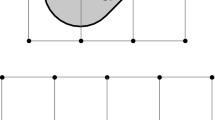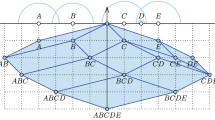Abstract
In this paper, a new approach to the discretization of n-dimensional Euclidean figures is studied: the discretization of a compact Euclidean set K is a discrete set S whose Hausdorff distance to K is minimal; in particular such a discretization depends on the choice of a metric in the Euclidean space, for example the Euclidean or a chamfer distance. We call such a set S a Hausdorff discretizing set of K. The set of Hausdorff discretizing sets of K is nonvoid, finite, and closed under union; we consider thus in particular the greatest one among such sets, which we call the maximal Hausdorff discretization of K. We give a mathematical description of Hausdorff discretizing sets: it is related to the discretization by dilation considered by Heijmans and Toet and the cover discretization studied by Andrès. We have a bound on the Hausdorff distance between a compact set and its maximal Hausdorff discretization, and the latter converges (for the Hausdorff metric) to the compact set when the spacing of the discrete grid tends to zero. Such a convergence result holds also for the discretization by dilation when the structuring element satisfies the covering assumption. Our approach is here the most general possible. In a next paper we will consider the case where the underlying metric on points satisfies some general constraints in relation to the cells associated to the discrete points, and we will then see that these constraints guarantee that the usual supercover and cover discretizations give indeed Hausdorff discretizing sets.
Similar content being viewed by others
References
E. Andrès, “Cercles discrets et rotations discrètes,” Thèse de Doctorat, Université Louis Pasteur, Strasbourg, France, Dec. 1992.
E. Andrès, “Standard cover: A new class of discrete primitives,” Internal Report, IRCOM, Université de Poitiers, 1998.
E. Andrès, P. Nehlig, and J. Fran¸con, “Tunnel-free supercover 3D polygons and polyhedra,” in Proc. Eurographics'97, Budapest, Sept. 1997, D. Fellner and L. Szirmay-Kalos (Eds.), Vol. 16, No. 3, pp. C3-C13.
E. Andrès, P. Nehlig, and J. Françon, “Supercover of straight lines, planes and triangles,” in Proc. 7th Discrete Geometry and Computer Imagery (DGCI) Conference, Montpellier, France. LNCS, Vol. 1347, Springer-Verlag, 1997, pp. 243-254.
M.F. Barnsley, Fractals Everywhere, 2nd ed., Academic Press, 1993.
J.E. Bresenham, “Algorithm for computer control of a digital plotter,” IBM Systems Journal, Vol. 4, No. 1, pp. 25-30, 1965.
J.M. Chassery and A. Montanvert, Géométrie Discrète en Analyse d'Images, Hermès: Paris, 1991.
D. Cohen-Or and A. Kaufman, “Fundamentals of surface voxelization,” Graphical Models & Image Processing, Vol. 57, No. 6, pp. 453-461, 1995.
S. Duval and M. Tajine, “Digital geometry and fractal geometry,” in Proc. 5th Digital Geometry and Computer Imagery (DGCI) Conference, Clermont-Ferrand, France, 25-27 Sept., 1995, D. Richard (Ed.), pp. 93-104.
S. Duval, M. Tajine, and D. Ghazanfarpour, “Fractal modeling with infinite trees,” Theoretical Computer Science, submitted.
A. Giraldo, A. Gross, and L.J. Latecki, “Digitizations preserving shape,” Pattern Recognition, Vol. 32, No. 3, pp. 365-376, 1999.
A. Gross and L.J. Latecki, “Digitizations preserving topological and differential geometric properties,” Computer Vision & Image Processing, Vol. 62, No. 3, pp. 370-381, 1995.
A. Gross and L.J. Latecki, “A realistic digitization model of straight-lines,” Computer Vision & Image Processing, Vol. 67, No. 2, pp. 131-142, 1997.
A. Gross and L.J. Latecki, “Digital geometric methods in document image analysis,” Pattern Recognition, Vol. 32, No. 3, pp. 407-424, 1999.
R.C. Gonzalez and R.E. Woods, Digital Image Processing, Addison-Wesley, 1992.
H.J.A.M. Heijmans, “Morphological discretization,” in Geometrical Problems in Image Processing, U. Eckhardt et al. (Eds.), Akademie Verlag: Berlin, 1991, pp. 99-106.
H.J.A.M. Heijmans, “Discretization of morphological operators,” J. Visual Communication & Image Representation, Vol. 3, No. 2, pp. 182-193, 1992.
H.J.A.M. Heijmans, Morphological Image Operators, Academic Press: Boston, 1994.
H.J.A.M. Heijmans and C. Ronse, “The algebraic basis of mathematical morphology I: dilations and erosions,” Computer Vision, Graphics&Image Processing,Vol. 50, No. 3, pp. 245-295, 1990.
H.J.A.M. Heijmans and J. Serra, “Convergence, continuity and iteration in mathematical morphology,” J. Visual Communication & Image Representation, Vol. 3, No. 1, pp. 84-102, 1992.
H.J.A.M. Heijmans and A. Toet, “Morphological sampling,” Computer Vision, Graphics & Image Processing: Image Understanding, Vol. 54, No. 3, pp. 384-400, 1991.
J.G. Hocking and G.S. Young, Topology, Dover Publications Inc.: New York, 1988.
R. Hummel and D. Lowe, “Computational considerations in convolution and feature-extraction in images,” in From Pixels to Features, J.C. Simon (Ed.), Elsevier Science Publishers (North-Holland): Amsterdam, 1989, pp. 91-102.
R. Klette, “The m-dimensional grid point space,” Computer Vision, Graphics, & Image Processing, Vol. 30, No. 1, pp. 1-12, 1985.
L.J. Latecki, C. Conrad, and A. Gross, “Preserving topology by a digitization process,” J. Mathematical Imaging & Vision, Vol. 8, pp. 131-159, 1998.
G. Matheron, Random Sets and Integral Geometry, J. Wiley & Sons: New York, 1975.
T. Pavlidis, Algorithms for Graphics and Image Processing, Springer-Verlag: Berlin, 1982.
J.-P. R´eveillès, “Géométrie discrète, calcul en nombres entiers et algorithmique,” Thèse de Doctorat d'Etat, Universit´e Louis Pasteur, Strasbourg, France, Dec. 1991.
C. Ronse, “A bibliography on digital and computational convexity,” IEEE Trans. Pattern Analysis & Machine Intelligence, Vol. 11, No. 2, pp. 181-190, 1989.
C. Ronse and M. Tajine, “Hausdorff discretization for cellular distances, and its relation to cover and supercover discretizations,” submitted.
P.V. Sankar, “Grid intersect quantization schemes for solid object digitization,” Computer Graphics & Image Processing, Vol. 8, pp. 25-42, 1978.
M. Schmitt, “Digitization and connectivity,” in Mathematical Morphology and its Applications to Image and Signal Processing IV, H. Heijmans and J. Roerdink (Eds.), Kluwer Academic Publishers, June 1998, pp. 91-98. International Symposium on Mathematical Morphology 1998.
J. Serra, Image Analysis and Mathematical Morphology, Academic Press: London, 1982.
J. Serra, Image Analysis and Mathematical Morphology, Vol. 2: Theoretical Advances, Academic Press: London, 1988.
K. Sivakumar and J. Goutsias, “On the discretization of morphological operators,” J. Visual Communication & Image Representation, Vol. 8, No. 1, pp. 39-49, 1997.
M. Tajine and C. Ronse, “Preservation of topology by Hausdorff discretization, and comparison to other discretization schemes,” submitted.
M. Tajine and C. Ronse, “Hausdorff sampling of closed sets into a boundedly compact space,” in preparation.
M. Tajine, D. Wagner, and C. Ronse, “Hausdorff discretization and its comparison to other discretization schemes,” in Proc. 9th Digital Geometry and Computer Imagery (DGCI) Conference, Paris. LNCS, Vol. 1568, Springer-Verlag, 1999, pp. 399-410.
D. Wagner, “Distance de Hausdorff et problème discretcontinu,” Mémoire de D.E.A. (M.Sc. Dissertation), Université Louis Pasteur, Strasbourg (France), June 1997. URL: http:// orange.u-strasbg.fr/FIPA/DEA 97 Wagner.ps.gz
D.Wagner,M. Tajine, and C. Ronse, “An approach to discretization based on the Hausdorff metric,” in Mathematical Morphology and its Applications to Image and Signal Processing IV, H. Heijmans and J. Roerdink (Eds.), Kluwer Academic Publishers, June 1998, pp. 67-74. International Symposium on Mathematical Morphology 1998.
Author information
Authors and Affiliations
Rights and permissions
About this article
Cite this article
Ronse, C., Tajine, M. Discretization in Hausdorff Space. Journal of Mathematical Imaging and Vision 12, 219–242 (2000). https://doi.org/10.1023/A:1008366032284
Issue Date:
DOI: https://doi.org/10.1023/A:1008366032284




